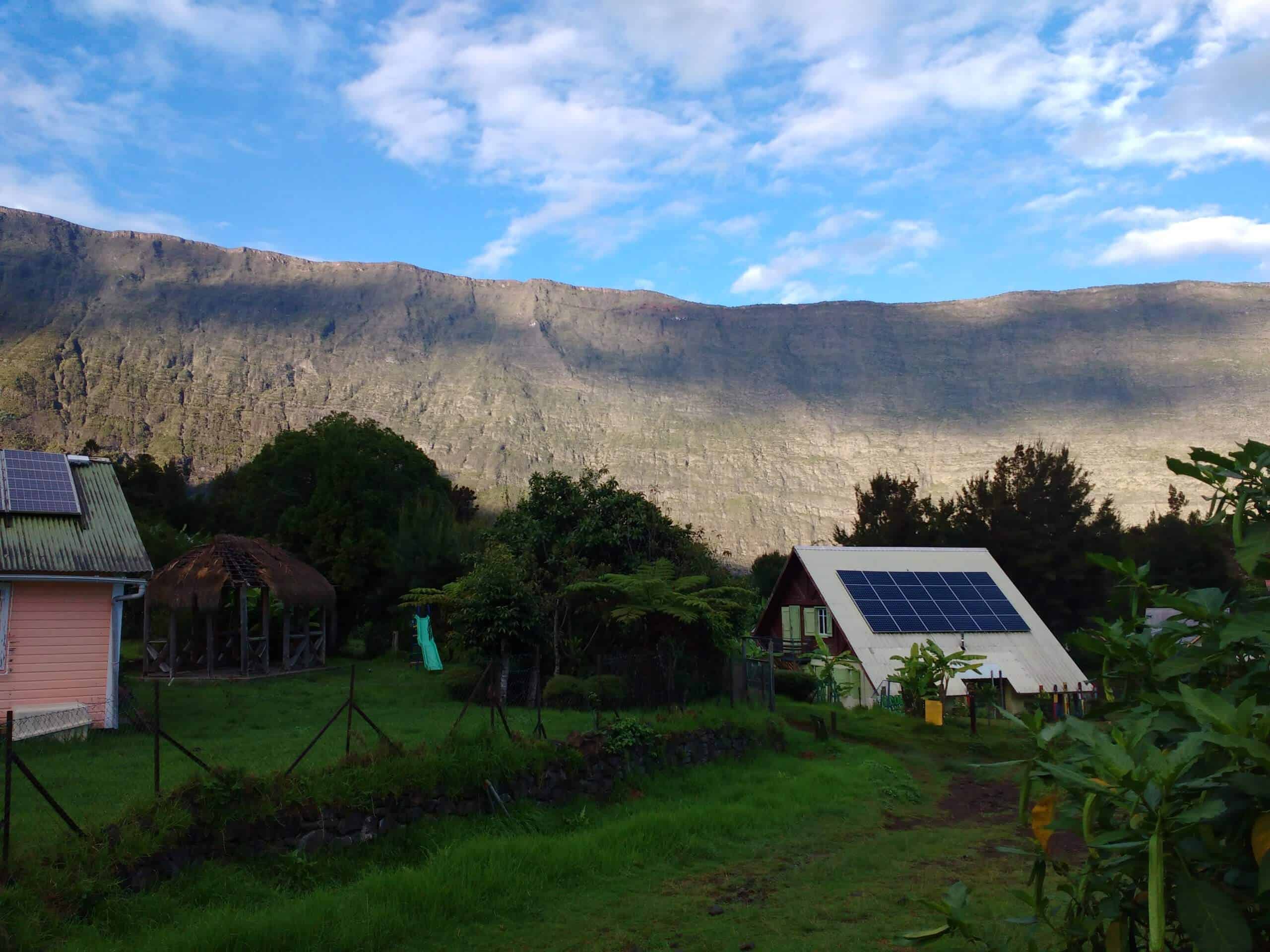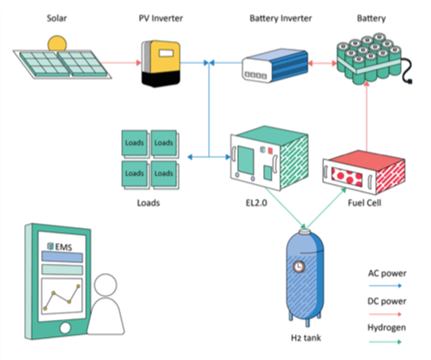ADB – How to Light Up Remote Areas with Clean Hydrogen
By Vaitea Cowan and Thomas Chrometzka, in ADB
November 17, 2019

Introduction
Hydrogen is an energy carrier like electricity. However, it is more versatile. It can be the base for any gas, fuel, or can be transformed into electricity. If made from renewables, hydrogen is carbon-free.
Hydrogen offers the potential for full energy autonomy and independence. Rather than using diesel generators, microgrids can integrate hydrogen as a pollution-free alternative. Made from 100% renewable electricity, it allows large amounts of renewables to be stored for later use.
Why use hydrogen to live off-grid?
Hydrogen can be made via a process called water electrolysis. Electricity is used to split water into its component gases: hydrogen and oxygen. If solar or wind power is used, this energy is carbon-free—with zero emissions. Electrolysis used to be prohibitively expensive, but costs have come down.
The Phi Suea House in Chiang Mai, Thailand is Southeast Asia’s first multi-residential project to be fully powered by solar energy paired with a hydrogen storage system. The hybrid hydrogen-battery system maximizes the advantages of both the hydrogen storage system and electrical batteries. The energy of the sun is transformed into electricity via solar panels. Any excess power will be converted and stored as hydrogen. When the sun doesn’t shine, the hydrogen gas stored in tanks generate electricity by using fuel cells.
Where else is the technology used?
The technology is used in many places. In Reunion Island, the Mafate Circus is accessible only by helicopter or foot. Its hydrogen-backed energy system is fully fossil fuel-free and has provided energy to several houses, a school, a workshop and medical dispensary since 2017. The mini grid runs on 8.7-kilowatt peak (kWp), produces 500 liters of hydrogen per hour and has a 15.6-kilowatt hour (kWh) battery storage installed.
In Uganda, a containerized solution provides rural electrification for communities in Kyenjojo. The 20-foot container solution is a complete solar power solution with 4.7kWp installed, and includes a storage system made of hydrogen and a battery. Hydrogen is made from solar energy, and electrolyzers generate 2,000 liters per hour.
There are several other hydrogen microgrids like the Stone Edge Farm Microgrid in Sonoma Valley, California and the Orkney Islands microgrid.
How do you build a hydrogen microgrid?
A hydrogen microgrid setup requires the following:
- Renewable energy. Solar or wind are both suitable for providing onsite, pollution-free energy for local consumption.
- Inverters. Either a photovoltaic (PV) or wind inverter paired with a battery inverter are necessary.
- Batteries are integrated in the system to buffer the main load and build the grid.
- Electrolyzers use electricity to split water into hydrogen and oxygen.
- A hydrogen storage tank keeps the gas for later use. Hydrogen can be stored without time or quantity limitations, and at low or high pressure.
- Fuel cells transform hydrogen back into electricity when needed.
- A sophisticated Energy Management system makes distributed networks work. It provides secure and reliable interconnection for monitoring and enable remote control.
Figure 1: Hydrogen Microgrid System Diagram

Is hydrogen safe?
Hydrogen is a flammable gas and like with any other gas, there are safety measures when handling it. Hydrogen devices, such as electrolyzers and fuel cells, are built as intrinsically safe devices. When the electrolyzer is running, sensors detect leaks or pressure changes. In case of an error, the device would shut itself down immediately, and send an alarm or error message. This way, the user steers clear of any risk of combustion. Also, hydrogen’s properties make it safer to handle than commonly used fuels. It is non-toxic, and it is an element lighter than air, so, it will quickly disperse in case of a leak. All it would need is a place to escape.
What are the advantages and disadvantages of microgrids?
The advantages of a hydrogen minigrid are long-term energy storage and clean backup energy. At the core, it only requires electricity to split water, which can be tap or rainwater. Hydrogen energy does not depreciate; it stores and provides decentralized energy access for weeks. Software is also available for fast integration and remote monitoring and control.
The current disadvantage is that not many microgrid developers are familiar with using hydrogen as a storage solution, but building hydrogen microgrids with a modular system can be simple and quick (see Enapter’s electrolyzer setup guide and technical documentation). The special requirements for maintaining a hydrogen microgrid is replacing the electrolyte solution in the electrolyzer every 6 months or checking for dust in the system. Other basic microgrid maintenance principles apply here too.
Compared to other energy solutions, a solar-plus-hydrogen set up will have zero direct emissions. A community of 300 inhabitants on the island of Koh Jik, Thailand will use hydrogen for energy storage. The daily energy consumption of the entire island is 265kWh, or 96,725 kWh per year. With diesel generators as backup energy supply, the island’s diesel consumption was reduced to 37,000 liters.
Over the system’s lifetime of 20 years, electricity generation from a solar-hydrogen minigrid in Koh Jik can cost between 0.5-0.6 euro/kWh (according to price points as of October 2019). Minigrids that are 100% diesel have generation costs that go beyond 0.6 Euro/kWh, with cost highly influenced by volatile fuel prices.
How can microgrids provide electricity to poor communities in rural and remote areas, particularly in Asia and the Pacific?
Asia–Pacific countries have abundant sun, and microgrids can electrify remote areas using solar power. These have the potential to supply hydrogen endlessly. All one needs is sun and water.
The cost of hydrogen depends on the cost of electricity. The cost of green electricity is low where renewables are abundant, as is the case in the Asia–Pacific region. The cost of hydrogen generation is falling too. Electrolyzer manufacturers are scaling their production and driving down costs. Modular solutions are coming to the market, so system integrators can choose hydrogen as a solution for long-term storage.
Green hydrogen helps countries provide a reliable and long-term solution for energy on-demand. For individuals, onsite production of hydrogen creates local sources of income from sunshine, rather than importing diesel. For the environment, in comparison to using diesel generators, an electrolyzer generating 500 liters of hydrogen per hour could prevent about 34 tons of carbon dioxide-equivalent emissions over its lifetime. The potential to stack electrolyzers gives countries the freedom to take ownership of their energy supply and demand.
Electrolyzer manufacturer Enapter was at the Dim Sum with Entrepreneurs session of the Asia Clean Energy Forum 2019, which is an annual event organized by the Asian Development Bank in Manila.
You may read the original version of this article here.
Resources
- Enapter. 2019. Quick Start Guide: Hydrogen Microgrids
- Enapter. 2019. System Setup for Hydrogen Hands-On Seminar
- Phi Suea House Project. 2015. Video: Phi Suea House Microgrid Explained. Youtube.
- Y. Zhai. 2019. It’s Clean, Powerful and Available: Are You Ready for Hydrogen Energy? Asian Development Blog. May.
